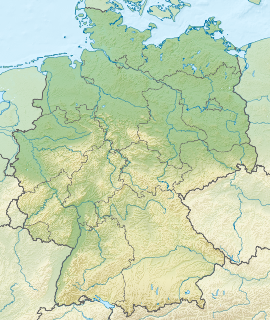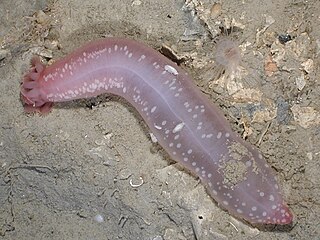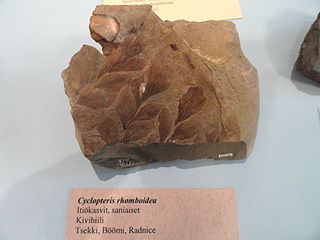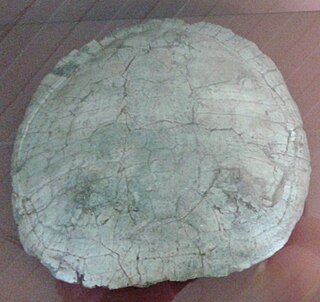
Cyclanorbis is a genus of softshell turtles in the family Trionychidae. The genus is endemic to Africa.

Chonetes is an extinct genus of brachiopods. It ranged from the Late Ordovician to the Middle Jurassic.
Rhabdoderma is an extinct genus of coelacanth fish in the class Sarcopterygii. It lived in the Carboniferous and Early Triassic, and its fossils have been found in Europe, Madagascar and North America.
Xenobrachyops is an extinct genus of temnospondyl amphibian from the Triassic of Australia, describing a single species, Xenobrachyops allos. It is estimated to have been around fifty centimetres long and its diet would have consisted of fish and insects.
Bohemiatupus is an extinct genus of griffenfly in the family Meganeuridae and containing a single species Bohemiatupus elegans. The species is known only from the Late Carboniferous, Bolsovian stage, Kladno Formation near the village of Radnice in the Radnice Basin, Czech Republic.

Chresmodidae is an extinct family of insects within the superorder Polyneoptera.

The Gehrener Schichten is a geologic formation in Germany. The fluvial to lacustrine shales preserve fossils dating back to the Late Carboniferous period.

Callista is a genus of saltwater clams, marine, bivalve molluscs in the family Veneridae, the venus clams.
Cyclocardia elegans is an extinct species of clam in the family Carditidae.
Digitolabrum is an extinct genus of sea snails in the family Aporrhaidae. Most species are from the Eocene of France. D. abedi and D. elegans are from the Eocene of Egypt.
Phragmolites is an extinct genus of molluscs in the family Bucaniidae, paleozoic molluscs of uncertain position possibly being either Gastropods or Monoplacophorans in the superfamily Bellerophontoidea.

Chiridota is a genus of sea cucumbers in the family Chiridotidae. It is an extant genus but some fossil species are known.
Plicochonetes is an extinct genus of brachiopods in the extinct family Rugosochonetidae.

Cyclopteris is an extinct genus of seed ferns in the extinct family †Cyclopteridaceae. Species are from the Carboniferous.
Drosophila elegans is a flower-feeding species of fruit flies, belonging to the family Drosophilidae. It is found in Taiwan and the Philippines in Asia.
Drosophila statzi is an extinct species of flies, belonging to the family Drosophilidae. It is from the Upper Oligocene of the Rott Formation in Germany.

Bauruemys is an extinct genus of turtles in the family Podocnemididae.

The Normandien Formation is a Triassic-age rock formation located in Free State, South Africa. It is where the fossils of Ericiolacerta, a subtaxa of Ericiolacertidae, was found.

The Whitehill Formation, alternatively written as White Hill Formation and formerly known as White Band or Whitehill or White Hill Member, is a regional Early Permian geologic formation belonging to the Ecca Group in the southeastern ǁKaras Region of southeastern Namibia and Eastern, Northern and Western Cape provinces of South Africa.










